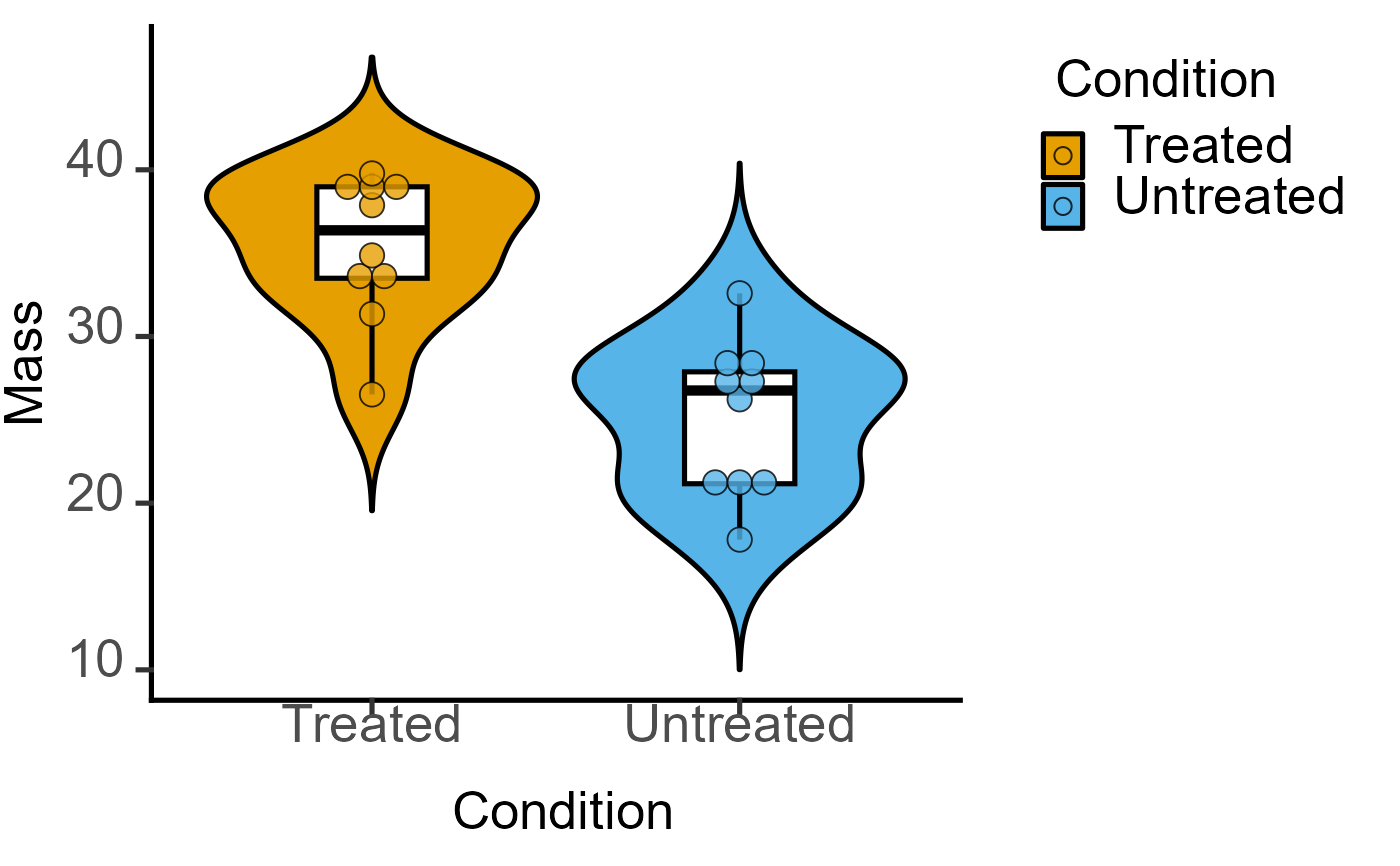There are three types of plot_dot_ functions that plot data as "dots" using the geom_dotplot geometry. They all take a data table, a categorical X variable and a numeric Y variable.
plot_dotbar_sd (bar & SD, SEM or CI95 error bars)
plot_dotbox (box & whiskers)
plot_dotviolin (box & whiskers, violin)
plot_dotviolin(
data,
xcol,
ycol,
facet,
dotsize = 1.5,
d_alpha = 0.8,
b_alpha = 0,
v_alpha = 1,
bwid = 0.3,
vadjust = 1,
trim = TRUE,
scale = "width",
TextXAngle = 0,
LogYTrans,
LogYBreaks = waiver(),
LogYLabels = waiver(),
LogYLimits = NULL,
facet_scales = "fixed",
fontsize = 20,
dotthick,
bthick,
vthick,
bvthick,
ColPal = c("okabe_ito", "all_grafify", "bright", "contrast", "dark", "fishy", "kelly",
"light", "muted", "pale", "r4", "safe", "vibrant"),
ColSeq = TRUE,
ColRev = FALSE,
SingleColour = "NULL",
...
)Arguments
- data
a data table object, e.g. data.frame or tibble.
- xcol
name of the column (without quotes) to plot on X axis. This should be a categorical variable.
- ycol
name of the column (without quotes) with the quantitative variable to plot on the Y axis. This should be a quantitative variable.
- facet
add another variable (without quotes) from the data table to create faceted graphs using
facet_wrap.- dotsize
size of dots relative to
binwidthused bygeom_dotplot. Default set to 1.5, increase/decrease as needed.- d_alpha
fractional opacity of dots, default set to 0.8 (i.e., 80% opacity).
- b_alpha
fractional opacity of boxplots. Default is set to 0, which results in white boxes inside violins. Change to any value >0 up to 1 for different levels of transparency.
- v_alpha
fractional opacity of violins, default set to 1.
- bwid
width of boxplots; default 0.3.
- vadjust
number to adjust the smooth/wigglyness of violin plot (default set to 1).
- trim
set whether tips of violin plot should be trimmed at high/low data. Default
trim = TRUE, can be changed to FALSE.- scale
set to "area" by default, can be changed to "count" or "width".
- TextXAngle
orientation of text on X-axis; default 0 degrees. Change to 45 or 90 to remove overlapping text.
- LogYTrans
transform Y axis into "log10" or "log2" (in quotes).
- LogYBreaks
argument for
scale_y_continuousfor Y axis breaks on log scales, default iswaiver(), or provide a vector of desired breaks.- LogYLabels
argument for
scale_y_continuousfor Y axis labels on log scales, default iswaiver(), or provide a vector of desired labels.- LogYLimits
a vector of length two specifying the range (minimum and maximum) of the Y axis.
- facet_scales
whether or not to fix scales on X & Y axes for all facet facet graphs. Can be
fixed(default),free,free_yorfree_x(for Y and X axis one at a time, respectively).- fontsize
parameter of
base_sizeof fonts intheme_classic, default set to size 20.- dotthick
thickness of dot border (
strokeparameter ofgeom_dotplot), default set tofontsize/22.- bthick
thickness (in 'pt' units) of boxplots; default =
fontsize/22.- vthick
thickness (in 'pt' units) of violins; default =
fontsize/22.- bvthick
thickness (in 'pt' units) of both violins and boxplots; default =
fontsize/22.- ColPal
grafify colour palette to apply (in quotes), default "okabe_ito"; see
graf_palettesfor available palettes.- ColSeq
logical TRUE or FALSE. Default TRUE for sequential colours from chosen palette. Set to FALSE for distant colours, which will be applied using
scale_fill_grafify2.- ColRev
whether to reverse order of colour within the selected palette, default F (FALSE); can be set to T (TRUE).
- SingleColour
a colour hexcode (starting with #, e.g., "#E69F00"), a number between 1-154, or names of colours from
grafifyor base R palettes to fill along X-axis aesthetic. Accepts any colour other than "black"; usegrey_lin11, which is almost black.- ...
any additional arguments to pass to
geom_boxplot,geom_dotplotorgeom_violin.
Value
This function returns a ggplot2 object of class "gg" and "ggplot".
Details
Related plot_scatter_ variants show data symbols using the geom_point geometry. These are plot_scatterbar_sd (or SEM or CI95 error bars), plot_scatterbox and plot_scatterviolin. Over plotting in plot_scatter variants can be reduced with the jitter argument.
The X variable is mapped to the fill aesthetic of dots, symbols, bars, boxes and violins.
Colours can be changed using ColPal, ColRev or ColSeq arguments. Colours available can be seen quickly with plot_grafify_palette.
ColPal can be one of the following: "okabe_ito", "dark", "light", "bright", "pale", "vibrant, "muted" or "contrast".
ColRev (logical TRUE/FALSE) decides whether colours are chosen from first-to-last or last-to-first from within the chosen palette.
ColSeq decides whether colours are picked by respecting the order in the palette or the most distant ones using colorRampPalette.
If you prefer a single colour for the graph, use the SingleColour argument.
Examples
#plot with trim = FALSE
plot_dotviolin(data = data_t_pdiff,
xcol = Condition, ycol = Mass,
dotsize = 2, trim = FALSE)
#> Bin width defaults to 1/30 of the range of the data. Pick better value with
#> `binwidth`.
 plot_dotviolin(data = data_t_pdiff,
xcol = Condition, ycol = Mass,
trim = FALSE, b_alpha = 0.5,
ColPal = "pale", ColSeq = FALSE)
#> Bin width defaults to 1/30 of the range of the data. Pick better value with
#> `binwidth`.
plot_dotviolin(data = data_t_pdiff,
xcol = Condition, ycol = Mass,
trim = FALSE, b_alpha = 0.5,
ColPal = "pale", ColSeq = FALSE)
#> Bin width defaults to 1/30 of the range of the data. Pick better value with
#> `binwidth`.
 #single colour along X
plot_dotviolin(data = data_t_pdiff,
xcol = Condition, ycol = Mass,
trim = FALSE, b_alpha = 0.5,
SingleColour = "pale_cyan")
#> Bin width defaults to 1/30 of the range of the data. Pick better value with
#> `binwidth`.
#single colour along X
plot_dotviolin(data = data_t_pdiff,
xcol = Condition, ycol = Mass,
trim = FALSE, b_alpha = 0.5,
SingleColour = "pale_cyan")
#> Bin width defaults to 1/30 of the range of the data. Pick better value with
#> `binwidth`.
